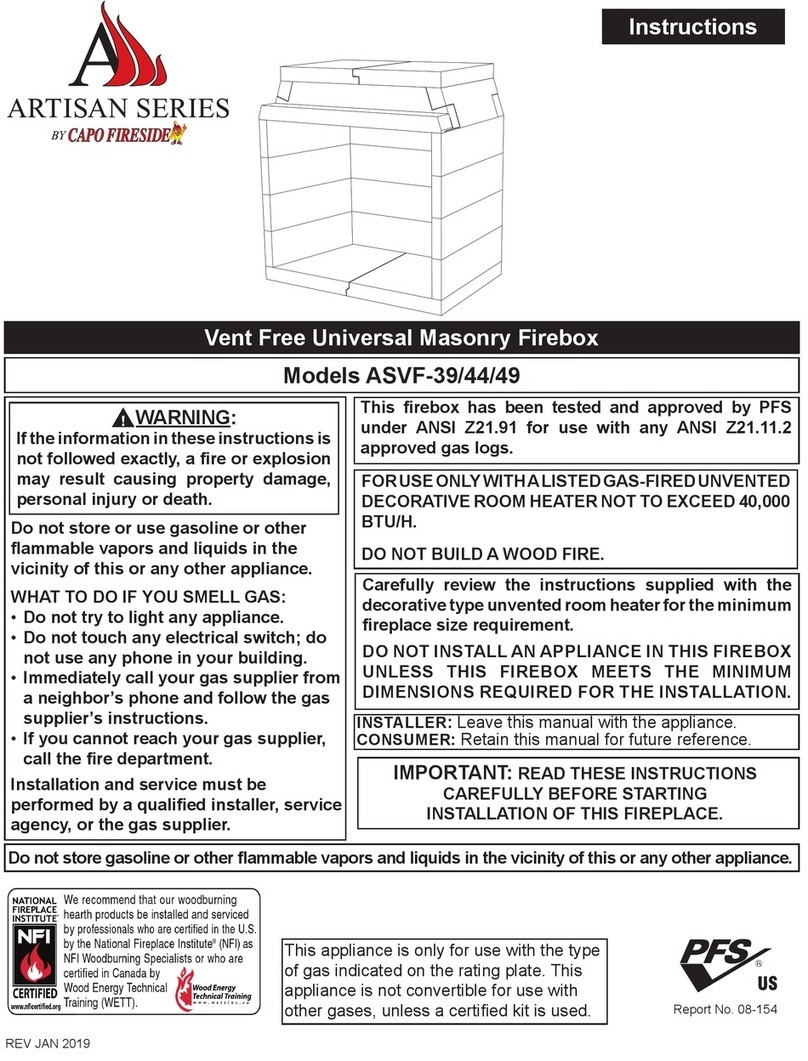Below is a sample picture of the rating plate that is located inside the lower dome side of your replace. Model Number, Date Of
Manufacture and Serial Number should be stamped on the plate where indicated.
7. HOLES: 4X Ø 0.14” THRU
6. CLEAR BOXES NEXT TO MODEL NUMBERS ARE TO BE STAMPED DURING MANUFACTURE OF FIREPLACE.
5. LARGE TEXT TO BOLD UPPERCASE ARIAL, 10 PT. MIN. (WHERE SHOWN).
4. SMALLEST TEXT TO BE ARIAL, 8 PT. MIN (WHERE SHOWN).
3. ALL TEXT AND GRAPHICS TO BE BLACK ON A CONTRASTING, CLEAR ALUMINUM BACKGROUND.
2. FINISH: CLEAR, PROTECTIVE COATING AT RATED TEMPERATURE IN NOTE 1.
1. MATERIAL: CLASS IIIA , .024 THICK ALUMINUM RATED AT 302°F (150°C).
NOTES: UNLESS OTHERWISE SPECIFIED
DESCRIPTION: ASL RATING PLATE
P/N: ASL-RP-A
REV. A
DATE: 4/30/2018
LAST MODIFIED BY: CB
Doc File Name: ASL RATING PLATE.ai
5.00” 4.75”
7.00”
6.75”
.12”
MODEL: ASL- 48 60 72 84 96 108 120
DATE OF MFG. SERIAL No.
This appliance is not for installation in manufactured or mobile homes.
ASL-RP-A
FOR MANTEL CLEARANCES
CONSULT OWNER’S MANUAL
DO NOT REMOVE THIS LABEL
See installation & operating instructions
for this model. Contact local building
officials about restrictions and installation
specifications in your area.
THIS FIREPLACE IS DESIGNED FOR USE ONLY WITH THE ANSI Z21.50-2016 DECORATIVE GAS SYSTEM AND BURNER TESTED AND
APPROVED FOR THIS FIREPLACE. Consult instructions included with this firebox for further information.
!
WARNING: Use only approved, listed 12ӯ B-Vent System. This Gas
Fireplace has been tested to operate with a gas burner and may be used with
automatic vent damper device p/n: EXH2812-24. Follow installation instructions.
Note: Certain installation conditions may require an Enervex Exhausto
Termination System including ADC100 Controller. Consult Manual.
Chimney Heights: Horizontal vent runs are approved for up to 70 feet with a
qty. of up to six (6) 90° elbows, with the use of a Power Vent. Vertical vent runs
are approved up to 60 feet with a maximum of two (2) 45° elbows.
VENTED DECORATIVE GAS APPLIANCE: NOT A SOURCE OF HEAT; NOT FOR USE WITH SOLID FUEL.
MANIFOLD PRESSURE: 5 INCHES W.C.
ELECTRICAL RATING: 120V / 60HZ
GAS TYPE: NATURAL
Test Report No. RAD-6053
!
WARNING: THIS FIREPLACE HAS BEEN TESTED FOR USE ONLY WITH APPROVED GLASS DOORS.
TO REDUCE THE RISK OF FIRE OR INJURY, CONSULT OWNER’S MANUAL.
THIS APPLIANCE NEEDS FRESH AIR FOR SAFE OPERATION AND MUST BE INSTALLED
SO THERE ARE PROVISIONS FOR ADEQUATE COMBUSTION AND VENTILATION AIR.
!
WARNING:
THIS FIREPLACE IS NOT INTENDED FOR BURNING SOLID FUELS.
!
WARNING:
This gas appliance must not be connected to a chimney fuel servicing a solid fuel burning appliance.
!
FIREPLACE CLEARANCES TO COMBUSTIBLES:
UNIT FRONT, SIDES, REAR...............................2” (50,8 mm)
COMBUSTIBLE FLOOR......................................6” (152,4 mm)
SHEATHING OR TRIM TO OPENING SIDES.....8“ (203,2 mm)
COMB. SHEATHING ABOVE OPENING TOP.....8” (203,2 mm)
OPENING TO SIDE WALL.................................20” (508 mm)
HEARTH EXTENSION BEYOND SIDES...........12“ (304,8 mm)
INSULATION FROM FIREBOX............................0
The installation, including provisions for combustion, ventilation air, and required minimum permanent vent opening,
must conform with the National Fuel Gas Code (ANSI Z223.1/NFPA 54) and applicable local building codes.
LARR No. 25924
26401 Via De Anza,
San Juan Capistrano, California 92675
H-BURNER BTU/HR: 85,000 100,000 120,000 140,000 160,000 180,000 200,000
GAS LOG-BURNER BTU/HR: 85,000 96,000 110,000 125,000 135,000 155,000 180,000
Tested &
Listed By




























